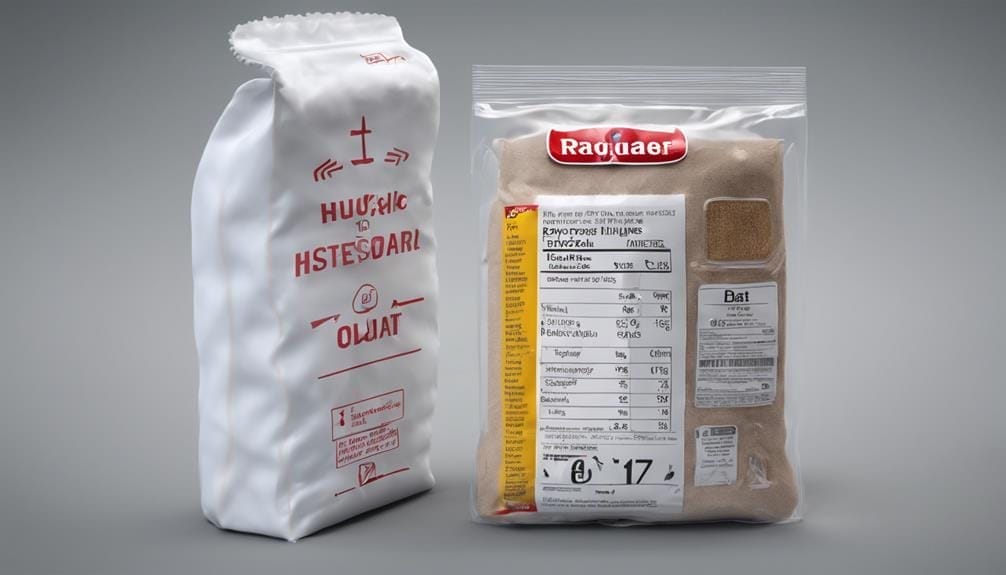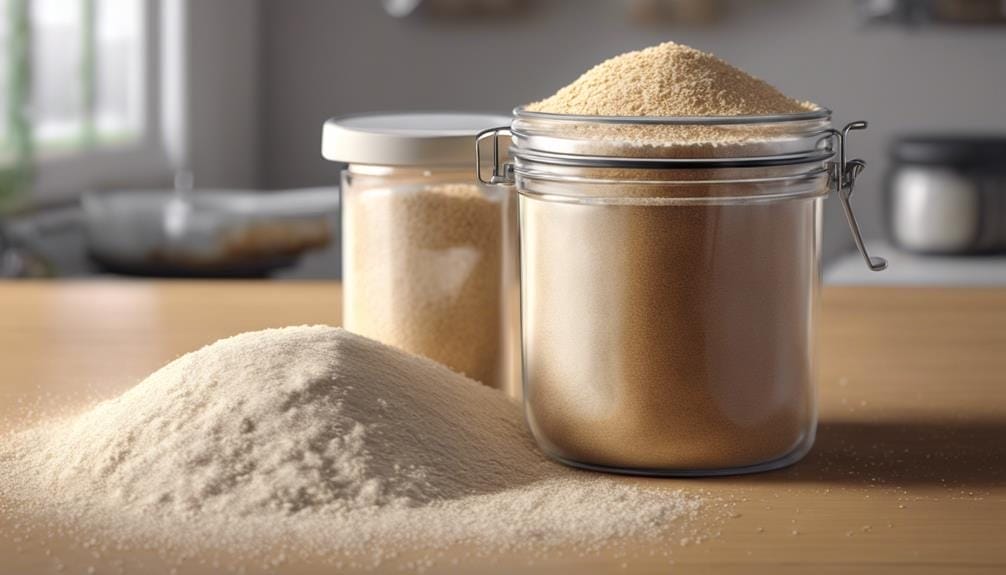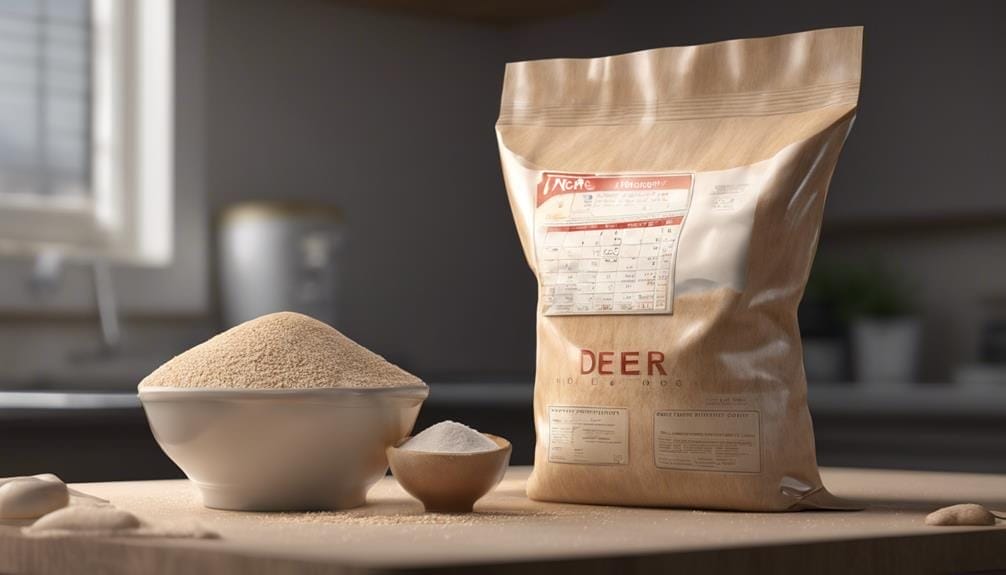White flour typically lasts about 3 months at room temperature in an airtight container. Make sure it's shielded from heat and light, and check for any unusual smells or signs of spoilage. If stored in a cooler environment like a pantry, it can stay fresh for up to 6 months. Refrigerating extends its shelf life to about 1 year, protecting it from rancidity and moisture. For longer storage, freeze in airtight containers, labeling with the date. Whole-wheat flour has shorter lifespans, lasting 1 month at room temp, 6 months in the fridge and about a year in the freezer. Want to preserve your flour?
White Flour at Room Temperature
White flour stored at room temperature typically lasts about 3 months before losing freshness.
To extend the shelf life of white flour, it's important to store it in an airtight container to prevent exposure to air and moisture, which can accelerate spoilage. Make sure to keep the flour away from heat sources and direct sunlight as these can also impact its freshness.
Regularly check the white flour for any off odors or signs of spoilage such as the presence of insects.
By following these simple storage guidelines, you can maintain the quality of your white flour for a longer period.
White Flour in Cooler Environment
To maintain the freshness of flour in a cooler environment, proper storage conditions are essential. Follow these tips to guarantee your white flour stays at its best:
- Choose the Right Spot: Store white flour in a pantry, kitchen cabinet, or cellar to benefit from the cooler temperatures that can help extend its shelf life.
- Maintain Quality: Regularly check your white flour for any signs of spoilage. Look out for unusual odors, discoloration, or insects that may indicate it's time to replace the flour.
- Seal it Tight: Keep white flour in airtight containers to prevent moisture and pests from affecting its quality. Mason jars or food-grade plastic containers work well for this purpose.
- Rotate Stock: Use the 'oldest in, oldest out' rule to ensure you're always using the oldest flour first. This practice helps maintain the freshness of your white flour supply.
White Flour in Fridge

Storing flour in the fridge helps prolong its freshness and prevents rancidity. White flour can last up to 1 year when refrigerated, maintaining its quality and flavor. Using airtight containers in the fridge is crucial for extending the shelf life of white flour and protecting it from moisture and odors.
| Benefits of Storing White Flour in the Fridge |
|---|
| 1. Extends shelf life by up to 1 year |
| 2. Prevents rancidity |
| 3. Maintains quality and flavor |
| 4. Protects from moisture and odors |
Properly sealed containers in the fridge can keep white flour fresh for longer periods, making it ideal for baking needs. Remember to label the containers with the date of storage for easy tracking. By refrigerating white flour in airtight containers, you make sure it stays in excellent condition for your culinary creations.
White Flour in Freezer
For longer preservation, consider freezing your flour instead of refrigerating it. Freezing white flour can greatly extend its shelf life compared to storing it at room temperature.
Here are some crucial tips for storing white flour in the freezer:
- Utilize airtight containers: Seal white flour in airtight containers before placing them in the freezer to prevent moisture and odors from affecting the flour.
- Label containers: Remember to label the containers with the date of freezing to keep track of the flour's freshness and make sure you use the oldest flour first.
- Long-term storage: White flour can last up to 2 years in the freezer while maintaining its quality, making it an excellent option for long-term storage.
- Extend shelf life: By freezing white flour, you can prolong its shelf life beyond the typical 6-8 months at room temperature, ensuring it stays fresh for your baking needs.
Whole-Wheat Flour at Room Temperature

Whole-wheat flour typically maintains its freshness for about 1 month when stored at room temperature, primarily due to its higher oil content.
To extend the shelf life of your whole-wheat flour, consider storing it in a cooler environment where it can last around 3 months.
For even longer freshness, refrigerating the whole-wheat flour is a great option, as it can stay good for up to 6 months.
If you want to preserve your whole-wheat flour for an extended period, freezing it's the way to go, as it can maintain its quality for up to 1 year.
Whole-Wheat Flour in Cooler Setting
To maintain the freshness of whole-wheat flour in a cooler setting, consider storing it in a cool environment where it can extend its shelf life to about 3 months.
Here are some tips for preserving your whole-wheat flour in a cooler setting:
- Store in a Cool Environment: Keep your whole-wheat flour in a cool place away from heat sources to maintain its freshness.
- Check Shelf Life: Be mindful of the expiration date on the packaging. Proper storage can help you make the most of the shelf life.
- Avoid Moisture: Moisture can lead to spoilage. Ensure the flour is stored in an airtight container to prevent it from getting damp.
- Regularly Rotate Stock: If you bake occasionally, consider using older flour before newer ones and replenishing with fresh stock to maintain quality.
Whole-Wheat Flour in Fridge

Consider storing your whole-wheat flour in the fridge to extend its shelf life and maintain freshness for up to 6 months. By keeping your whole-wheat flour in the fridge, you are helping to preserve its natural oils and nutrients, guaranteeing its quality for a longer period. The important role of the fridge also plays a key role in preventing the flour from quickly turning rancid. Moreover, storing whole-wheat flour in the fridge protects it from pests and moisture, which can lead to spoilage.
To help you understand the benefits of storing whole-wheat flour in the fridge, here is a table summarizing the advantages:
| Advantages |
|---|
| Maintains freshness |
| Extends shelf life |
| Preserves nutrients |
| Prevents rancidity |
| Protects from pests |
Remember to check your whole-wheat flour regularly for any signs of spoilage, such as off odors or bugs, to ensure it stays fresh throughout its storage in the fridge.
Whole-Wheat Flour in Freezer
Storing your whole-wheat flour in the freezer can greatly extend its shelf life and maintain its quality for up to a year. Here's why freezing your whole-wheat flour is a smart choice:
- Prevents Spoilage: Freezing whole-wheat flour helps prevent rancidity and spoilage, especially due to its higher oil content.
- Airtight Storage: To guarantee prolonged shelf life, store your whole-wheat flour in airtight containers or sealed bags in the freezer.
- Retains Nutritional Value and Flavor: Properly sealed whole-wheat flour in the freezer can preserve its nutritional value and flavor for an extended period, enhancing your baking results.
- Long-Term Preservation: By utilizing the freezer for whole-wheat flour storage, you can enjoy the benefits of prolonged shelf life while maintaining the quality of your flour for all your baking needs.
Freezing your whole-wheat flour is a simple yet effective way to maintain its freshness, nutritional value, and flavor, ensuring that your baked goods turn out delicious every time.
Frequently Asked Questions
Can You Use Flour 2 Years Out of Date?
If your flour is 2 years past the date, check for spoilage signs like odors, mold, or insects. White flour lasts longer than whole-wheat. Proper storage can extend flour's life. When unsure, do a sensory check before using.
How Can You Tell if Flour Has Gone Bad?
To check if flour's gone bad, use these tips: Smell for musty odors, check for mold, inspect color, taste for bitterness, feel texture. Always mind expiration date, store in sealed packaging in pantry or freezer.
How Long Can You Keep Flour Before It Goes Bad?
Store flour properly in a cool, dry place to preserve freshness. Label containers with purchase dates for tracking. Check for spoilage signs like odors, bugs, or mold. Room temp white flour lasts 6-8 months; frozen up to 2 years.
What Is the Longest Shelf Life of Flour?
For the longest shelf life of flour, consider storage conditions, flour types, baking tips, freshness tests, freezing flour, expiration dates, flour quality, nutritional value, homemade flour, and flour alternatives. Properly stored flour can last longer.
Conclusion
To sum up, the shelf life of flour varies depending on storage conditions. White flour can last longer than whole-wheat flour due to its lower oil content.
Storing flour in a cool, dark place will help prolong its freshness. For longer storage, consider keeping flour in the fridge or freezer.
By properly storing your flour, you can guarantee it stays fresh and ready to use for all your baking needs.